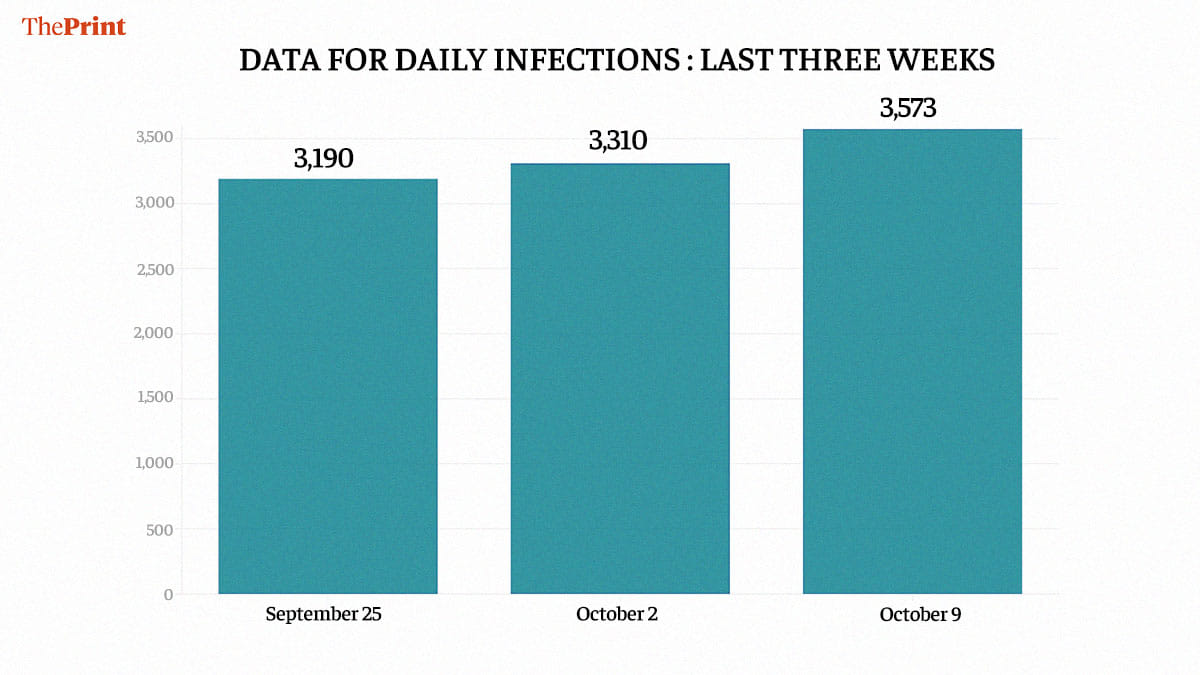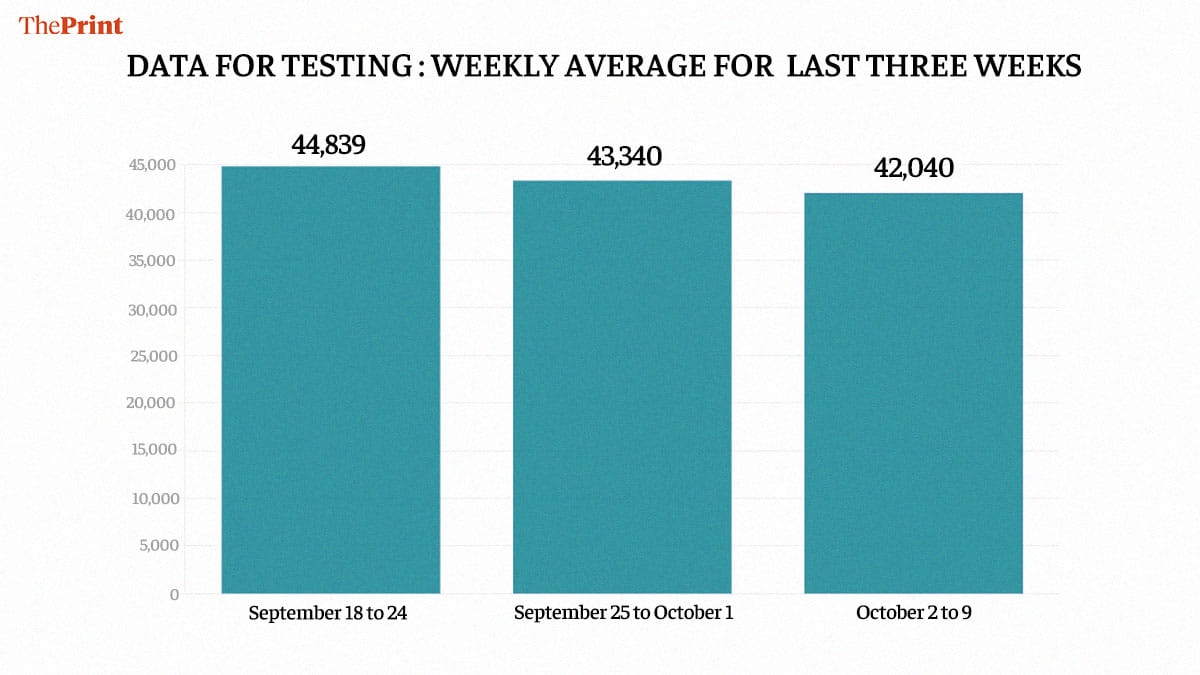Kolkata: West Bengal’s Covid-19 death toll has seen a sharp spike since 1 September, coupled with decreased tests and rising daily infection figures.
During a 41-day period — from 1 September to 11 October — the state has seen 2,399 deaths, which accounts for nearly 42 per cent of the total 5,682 deaths in Bengal.
The state’s mortality rate currently stands at around 2 per cent, higher than the national average of 1.5 per cent.
Since September, new cases per day have also been increasing, while the number of tests has decreased despite an increase in testing facilities.
With the upcoming Durga Puja festival and an election season looming, West Bengal seems to be staring at a grim Covid scenario.
Experts, meanwhile, attributed the rising death toll to delayed detection, late reporting to hospitals and virus load in patients.

The analysis
For a comparative analysis, ThePrint compiled the government data on testing for the last three weeks and calculated the weekly moving average. The analysis showed testing has fallen from 45,000 to 42,000 samples a day.
A week-on-week analysis of the daily cases since 18 September revealed how the number of daily infections kept rising and the number of tests kept falling. ThePrint has taken the Covid data of the last four Fridays to compare the numbers.
According to the government’s Covid bulletins, Bengal recorded 3,192 fresh cases on 18 September, 3,190 cases on 25 September, 3,310 cases on 2 October, and 3,573 cases on 9 October.
But, the weekly average of testing from 18-24 September was 44,839, from 25 September to 1 October, it was 43,340, and from 2-9 October, it stood at 42,040.

Testing went down in Bengal despite the state having no dearth in infrastructure, including number of laboratories, kits or reagents.
The state was testing around 45,000 samples a day in mid-September when it had 77 laboratories. But now with 89 laboratories, it is testing around 42,000 samples a day.
Professor Shamika Ravi, in a recent analysis on Bengal’s Covid situation, also highlighted the state’s “inadequate testing”.
How is #WestBengal doing? #COVID19India
1) Daily new cases continue to rise (unlike all-India).
2) Active cases growing in WB while declining all-India.
3) Death rate (1.9%) significantly higher than all-India (1.55%).
4) Inadequate testing. pic.twitter.com/ECKTADpMoB
— Prof Shamika Ravi (@ShamikaRavi) October 3, 2020
Also read: West Bengal Covid transmission rate dips to below 1, Delhi’s positivity increases to 8.64%
People reaching hospitals ‘very late’
Experts told ThePrint delayed detection of the infection is resulting in late reporting to hospitals, which is contributing to the rising death toll.
According to public health expert Dr Abhijit Choudhury, who is also a member of the chief minister’s Covid task force, deaths have risen in the last five weeks because people reached hospitals late and in “severe to very severe health conditions”.
“Early reporting at hospitals could have saved many. The mortality rate is almost constant. It has not gone up, but it has not gone down either. We will launch an awareness campaign for people to understand that oxygen and supportive care can save many lives,” he said.
“Doctors are getting not more than 10 days time to reverse the situation in many cases,” Choudhaury added.
Dr Subrata Pal, who is also a part of the government’s Covid panel, said the cause of deaths depends on the load of the virus.
“The virus load can be higher in a young person with low immunity as well. We need to take more precautions in such cases. But more people are dying for existing co-morbid conditions,” he added.
Dr Saswati Sinha, a senior doctor for critical care at one of the private hospitals in the city, said: “There are people who are reaching hospital very late.”
“Many of them are dying in a week or ten days. They report to hospital with severe conditions and with highly damaged organs. The second kind are comorbid patients,” she said.
Dr Partha Majumdar, founder of National Institute of Biomedical Genomics and a science chair of the Government of India, told ThePrint the ICMR in its guidelines mandated that tests should be done on demand and if necessary without a prescription.
But, many states have not been able to implement it, he added.
Dr Majumdar, who was involved in helping the Bengal government set up RT-PCR machines in districts during the initial stage of the pandemic, said: “In Bengal, people still need to show prescriptions and their Aadhaar card for testing at different facilities. This should not be the case. Instead, tests should be accelerated, and not decelerated.”
Also read: Bengal Covid tests much lower than India’s average, even Bihar, Assam & Odisha testing more
People ‘unwilling to get tested’
Asked about low testing, state health department officials claimed people are “unwilling to get tested” due to Covid fear and social stigma.
A senior health department official told ThePrint: “We are testing adequately. As per WHO norms, tests should be around 140 per million and at present, we are testing 522 per million.”
ThePrint reached the state’s Health Secretary N.S. Nigam via WhatsApp texts for a comment on low testing, but there was no response until the publication of this report.
Chief Minister Mamata Banerjee Monday said more people could be saved if they reported to the hospitals early.
Trinamool MP and former president of IMA, Dr Santanu Sen, blamed people’s “irresponsible behaviour” for rising Covid cases.
“We have noticed reluctance among people to wear masks. They refuse to maintain social distancing rules. If people behave irresponsibly, infections will rise. No government can do a man-marking process. This is not possible. Our chief minister has been on the streets from day one for people. She is doing her best,” he said.
“We have requested the health secretary to increase testing to a great extent after puja and that should continue for a month. He has assured us that testing will be increased.”
Bengal ‘lost its way in September’
Dr Kunal Sarkar, a senior cardiologist and a public health expert, said Bengal may have “lost its way in September”.
He said testing should have been upped ahead of the festival season.
“We perhaps lost our way in September. There has been a persistent mortality rate and a cruising positivity rate. In order to lower the mortality rate, one needs to detect the infection and provide oxygen support. Tests should be progressively upscaled and reduce positivity. Our positivity rate is still at 8 per cent,” he said.
According to Dr Sarkar, oxygen is the prime medicine in these cases.
“Critical patients have high dependency on oxygen. Most of the major private hospitals are highly stressed. Occupancy in private hospitals is above 80 per cent now. Important hospitals are running full,” he added.
Also read: Covid-dengue ‘co-infections’ are Bengal’s new challenge as doctors say treatment very tricky






